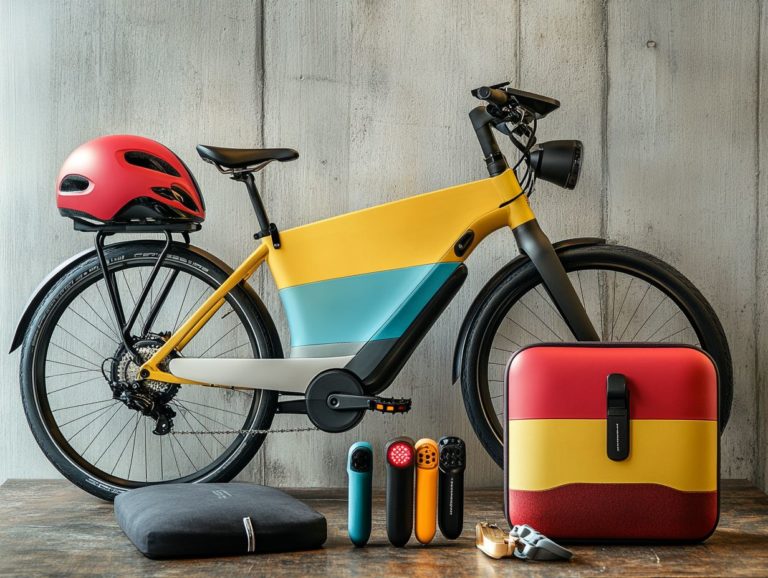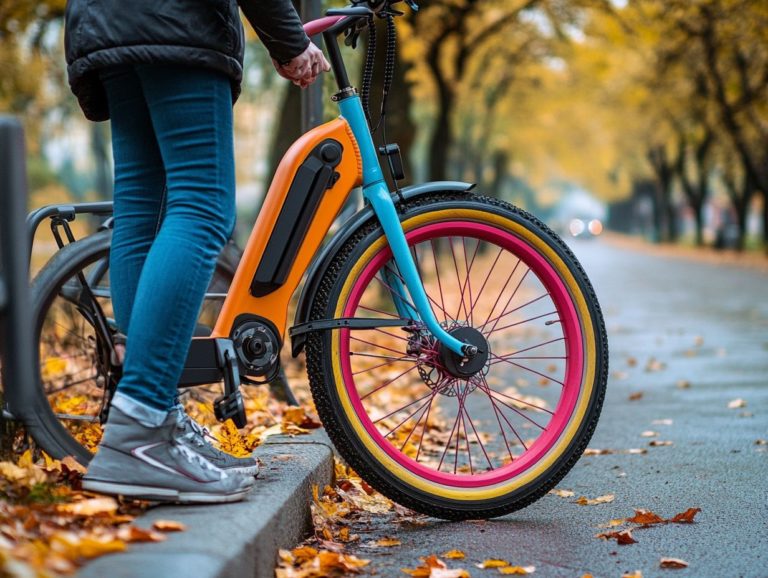How Do I Transport My Electric Bicycle?
Transporting an electric bicycle can feel intimidating, especially when safety and protection are at the forefront of your mind.
Whether you re gearing up for a weekend adventure or navigating your daily commute, understanding the best methods for transporting your e-bike will elevate your experience.
This article explores various options, from car racks to innovative folding and storage techniques. It highlights crucial considerations like weight limits and battery safety.
Get ready for valuable tips that will boost your confidence in securing your bike and reducing wear during transport. Keep reading to uncover the secrets to transporting your e-bike!
Contents
- Key Takeaways:
- Why is Transportation Important?
- Best Methods to Transport Your Electric Bicycle
- Considerations for Safe Transportation
- Tips for Transporting an Electric Bicycle
- Frequently Asked Questions
- What are some methods for transporting my electric bicycle?
- Can I transport my electric bicycle without a bike rack?
- How do I properly secure my electric bicycle on a bike rack?
- Can I transport my electric bicycle on public transportation?
- Are there any special considerations for air travel with my electric bicycle?
- Is it safe to transport my electric bicycle in extreme weather conditions?
Key Takeaways:
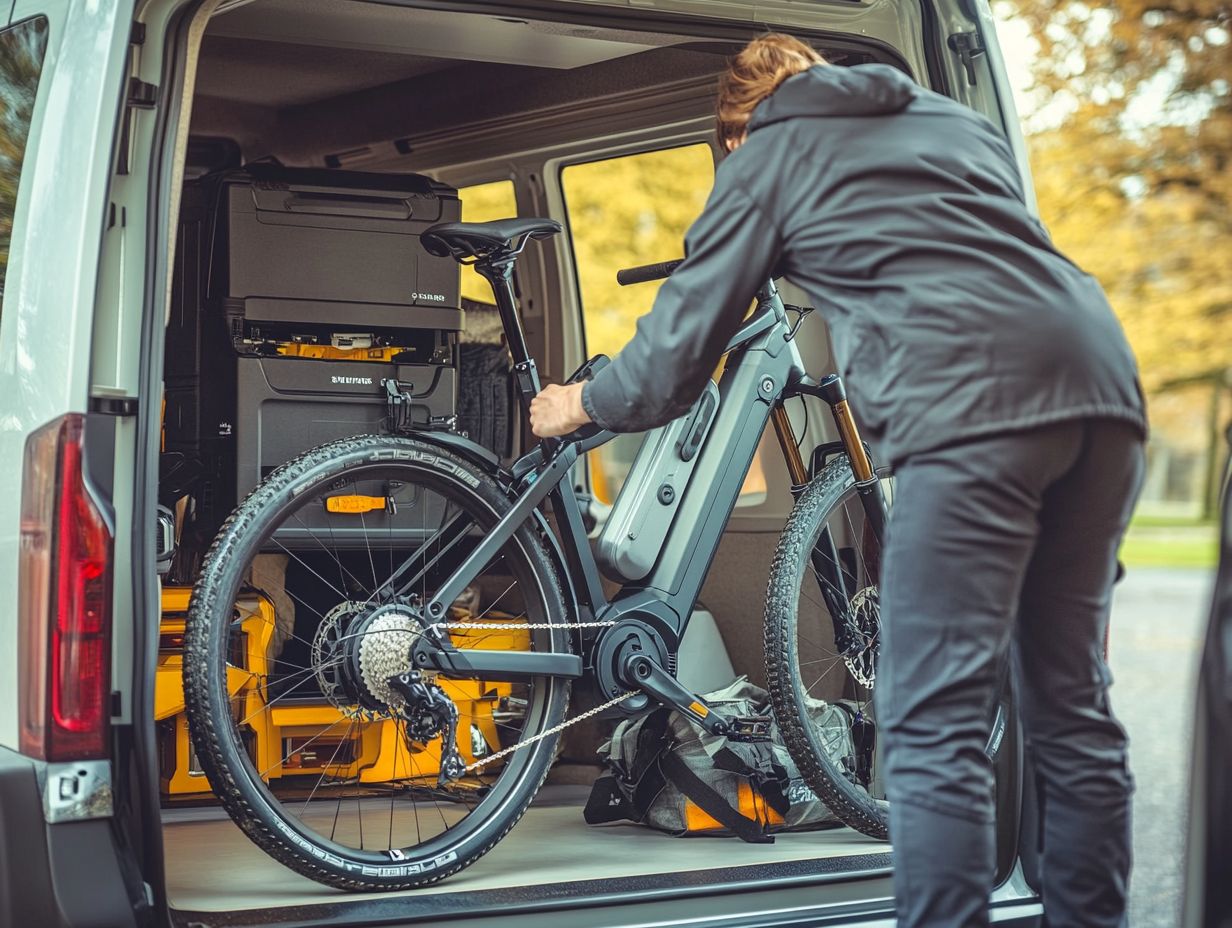
- Choose the right transportation method for your electric bicycle, whether it’s using a car rack or folding and storing it.
- Be aware of weight and size restrictions when transporting your electric bicycle, and take precautions to protect the battery and components.
- Secure your electric bicycle properly to minimize damage and ensure a safe ride.
Why is Transportation Important?
Transportation plays a vital role in modern life, helping people move easily across various sectors such as travel, logistics, and recreation.
Eco-friendly options like bikes and e-bikes are gaining popularity, focusing on sustainable transport solutions that cut down on carbon emissions and promote personal health and well-being.
Understanding the importance of effective transportation is essential in today s world, where urban congestion and environmental challenges are pressing issues.
Best Methods to Transport Your Electric Bicycle
Transporting an electric bicycle requires careful planning, with various strategies designed to preserve the bike’s integrity and safety during transit. Whether you opt for a traditional car rack, a van, or a U-Haul for longer trips, the method you choose greatly influences your e-bike’s performance and longevity.
By familiarizing yourself with these transport options, you’ll be equipped to make informed decisions that enhance your overall biking experience.
Using a Car Rack
Using a car rack is one of the most popular and effective ways to transport bikes and e-bikes. This method provides you with secure and convenient solutions that any avid cyclist will appreciate.
You have several options, including hitch-mounted, trunk-mounted, and roof racks, each catering to different needs in accessibility and stability.
For example, hitch-mounted racks generally offer higher weight capacities, making them a perfect choice for heavier e-bikes. On the other hand, trunk-mounted racks tend to be more budget-friendly and easier to install for those everyday bikes you love.
It s crucial to ensure that your bike rack is compatible with your specific bike model and meets your vehicle s specifications. Taking the time to secure your bike properly and being mindful of weight limits can prevent accidents and damage, giving you peace of mind as you hit the road.
Folding and Storing
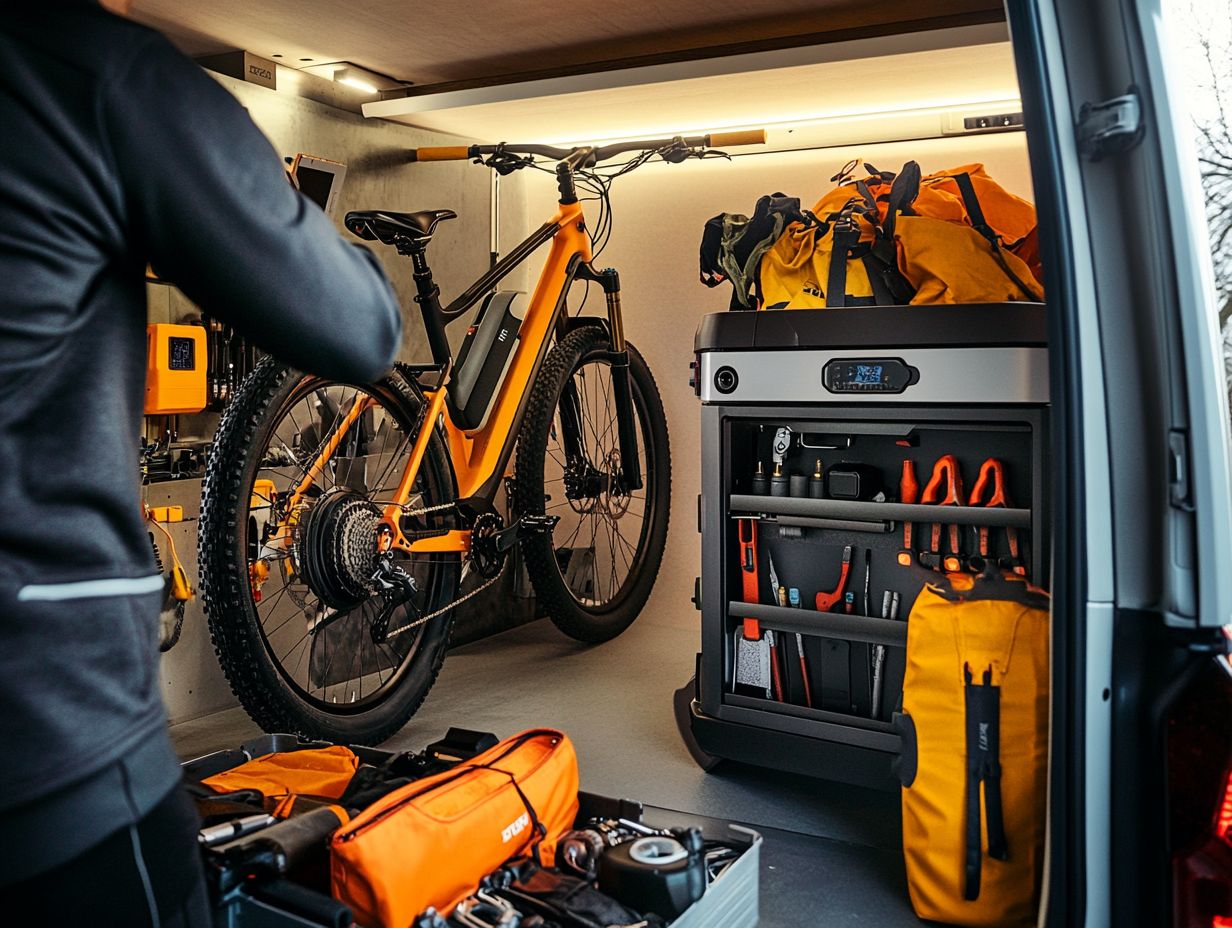
Folding and storing your e-bike is an excellent strategy for maximizing space and ensuring its protection during transportation and between rides.
Many e-bikes feature easy-to-use folding designs that allow for compact, easy carrying, which is particularly advantageous in urban environments with limited storage.
By mastering best practices for folding and storing, you can enhance your bike s longevity while safeguarding it from the elements.
Opting for models like the Brompton Electric or the Ancheer Folding E-Bike offers distinct advantages, including lightweight frames and robust folding designs.
These features make your daily commutes more manageable and simplify the process of transporting your e-bike in vehicles or on public transport.
In terms of storage, using covers specifically designed to protect your bike from dust and moisture is essential.
Always keep the bike’s weight restrictions in mind when loading, and ensure that your outdoor storage solutions, such as bike racks or sheds, provide adequate protection against harsh weather conditions.
Paying attention to detail helps your e-bike last longer!
Considerations for Safe Transportation
When transporting your bike or e-bike, consider several critical factors to ensure safe transit and protect your investment.
First, it s essential to be aware of the bike’s weight, as this will influence how you handle it.
Securing the battery, which powers your e-bike, is crucial to prevent any damage during the journey.
Using appropriate protectors will safeguard various components from potential harm.
Thoughtfully addressing these considerations can significantly reduce risks and extend the lifespan of your e-bike.
Weight and Size Restrictions
Understanding weight and size restrictions is crucial when transporting bikes and e-bikes.
This knowledge ensures you comply with carrier regulations and maintain safety on the road.
Various transport methods, such as car racks and U-Haul vans, come with specific weight limits that you must adhere to.
Exceeding these limits can lead to dangerous situations and even damage to your vehicle or the bike itself.
Being aware of these parameters empowers you to make informed choices during transportation.
To navigate these restrictions effectively, it’s essential to accurately weigh and measure your bike or e-bike before loading it for transit.
Most standard bike scales can provide a reliable weight reading, while a simple tape measure will yield the dimensions necessary to meet required specifications.
Keep in mind that different carriers impose varying limitations; for instance, some hitch-mounted racks can handle bikes weighing up to 60 pounds, while roof racks typically have lower thresholds.
Ensuring your bike or e-bike falls within these guidelines promotes safety and protects you from potential fines or damages during transport.
Protecting the Battery and Components
Are you ready to make your e-bike last longer? Protecting the battery and components of your e-bike during transportation is essential for maintaining its functionality and performance.
Electric bicycle batteries are sensitive to temperature fluctuations and physical damage, which is why it s crucial to use the right protectors and secure storage methods.
Taking these proactive steps means your e-bike is ready for your next adventure!
One highly effective strategy is to invest in specialized covers that provide insulation against both heat and cold, shielding the battery from extreme weather during transit.
Properly securing your bike in a vehicle with straps or a bike rack will prevent it from shifting and sustaining damage.
Choosing the right mode of transportation is equally vital; using a dedicated bike transport service or a well-padded vehicle offers extra cushioning against jolts.
Implementing these safety measures not only protects sensitive components but also extends the overall life of your e-bike.
These precautions are critical for any enthusiast looking to maintain their ride’s performance and longevity.
Tips for Transporting an Electric Bicycle
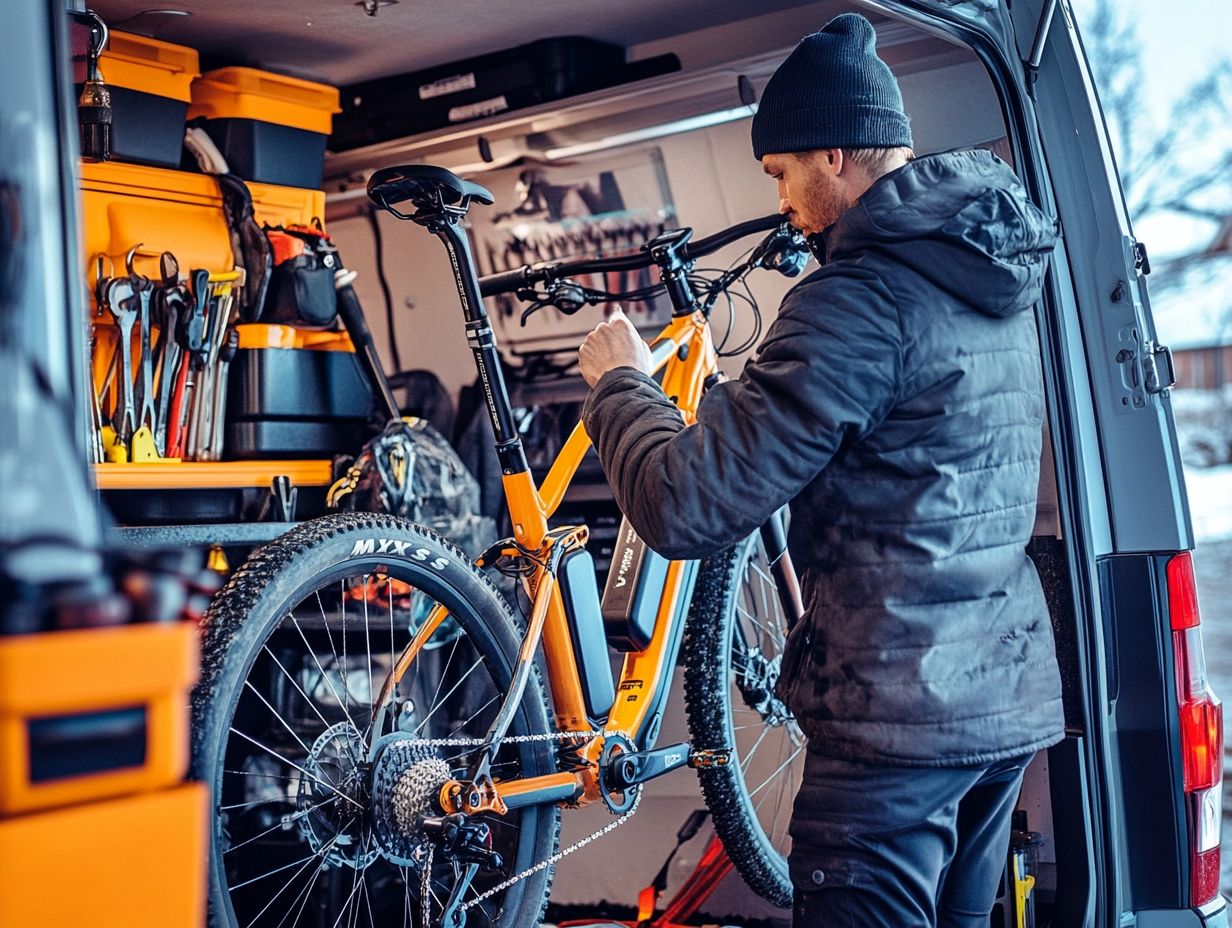
Transporting an electric bicycle can be a seamless endeavor if you adhere to key tips centered on security and minimizing damage. By properly securing your e-bike and understanding how to handle its delicate components, you can significantly reduce the risk of wear and tear during transit.
Taking a proactive approach guarantees a smooth transition from one location to another while safeguarding the condition of your bike.
Securing the Bicycle
Securing your bicycle or e-bike during transport is absolutely essential to fend off theft and prevent any damage. This is particularly important when you’re using a car rack or other transport methods.
Employ high-quality locks, ensure a secure attachment to the rack, and utilize additional straps to enhance the safety of your bike.
By mastering these best practices, you ll gain peace of mind and effectively protect your investment.
Properly adjusting the car rack to fit snugly is vital to prevent any unwanted movement during your journey. Incorporate locking skewers, which secure your wheels in place, or a detachable wheel lock to deter opportunistic thieves during pit stops.
If you re transporting via a truck or van, placing the bike in an enclosed space offers extra security. A bike cover can also keep it out of sight.
Consider using transport bags specifically designed for bicycles; they can protect against scratches and adverse weather conditions, ensuring your bike remains in pristine condition throughout the journey. If you own an electric bike, you might also want to learn how to store your electric bicycle properly for optimal maintenance.
Minimizing Damage and Wear
Protect your ride! Minimizing damage during transportation requires careful attention to detail and the right materials. Think about protective coverings, suitable transport methods, and how to handle your bike each can significantly impact its condition upon arrival.
High-quality protective padding, such as bubble wrap or foam, can be your best ally in shielding vulnerable components from impacts during transit. Properly secure the e-bike within the transport vehicle to reduce movement that could lead to scratches or mechanical damage.
Assess transport options that prioritize safety, whether you choose a professional service or a well-equipped personal vehicle. Communicating with your transport provider about any special handling requirements is essential.
This underscores the significance of careful loading and unloading techniques, safeguarding your investment throughout the journey.
Frequently Asked Questions
What are some methods for transporting my electric bicycle?

- Using a bike rack on a car
- Using a trailer
- Using a bike bag or case for air travel
Can I transport my electric bicycle without a bike rack?
Yes, you can transport your electric bicycle without a bike rack by using a trailer or placing it in the trunk or backseat of a car. However, using a bike rack is generally the easiest and safest option.
How do I properly secure my electric bicycle on a bike rack?
To secure your electric bicycle on a bike rack, use straps or bungee cords to secure the wheels and frame to the rack. Make sure the bike is stable and won’t slide or move during transport.
Can I transport my electric bicycle on public transportation?
Check your local public transport policies; they vary widely. Some may allow folding electric bikes, while others may have restrictions on the size and weight of bicycles allowed on board.
Are there any special considerations for air travel with my electric bicycle?
Yes, if you plan on flying with your electric bicycle, make sure to check with the airline beforehand to see if they have any specific guidelines or restrictions. You may also need to remove the battery and pack it separately.
Is it safe to transport my electric bicycle in extreme weather conditions?
It’s best not to transport your electric bicycle during extreme weather like heavy rain, snow, or intense heat. These conditions can harm the bike and its parts.
Wait for better weather or consider carrying it inside a vehicle. Protect your bike to keep it in great shape!



